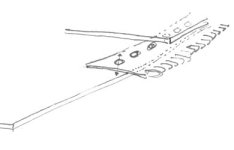that's a good idea. you have to work very precisely and cover the spokes with tape or something so the epoxy will not get into them I think. and maybe if you want to open a triangle form you probably have to split the zippers in two parts other than going around a curve while at the third side you could laminate in a fabric functioning as a hinge. I am not sure if you can use zippers other than straight (seen from "top view" of course). but I'm not sure about that.
also I would make sure that the epoxy can leak trough the fabric of the zipper eihter through the fabric net itself (if i's rough enough) or otherwise manually make some wholes in it. that way the epoxy will make a connection to the other side and the border area will be stronger.
also I would make sure that the epoxy can leak trough the fabric of the zipper eihter through the fabric net itself (if i's rough enough) or otherwise manually make some wholes in it. that way the epoxy will make a connection to the other side and the border area will be stronger.


